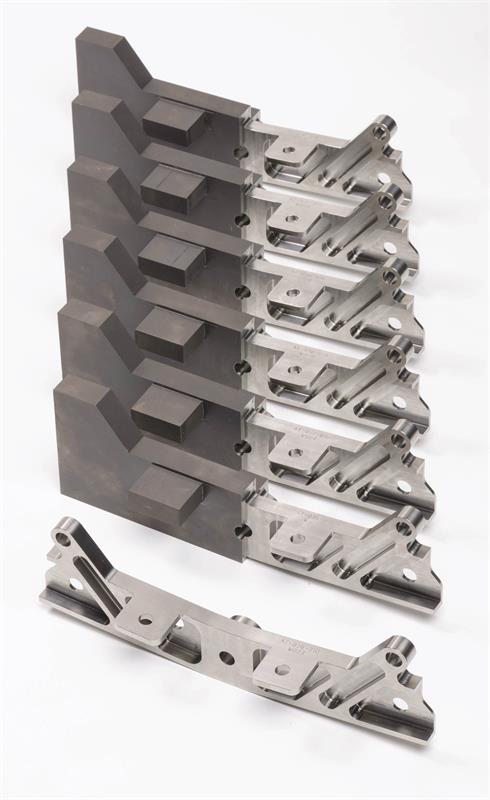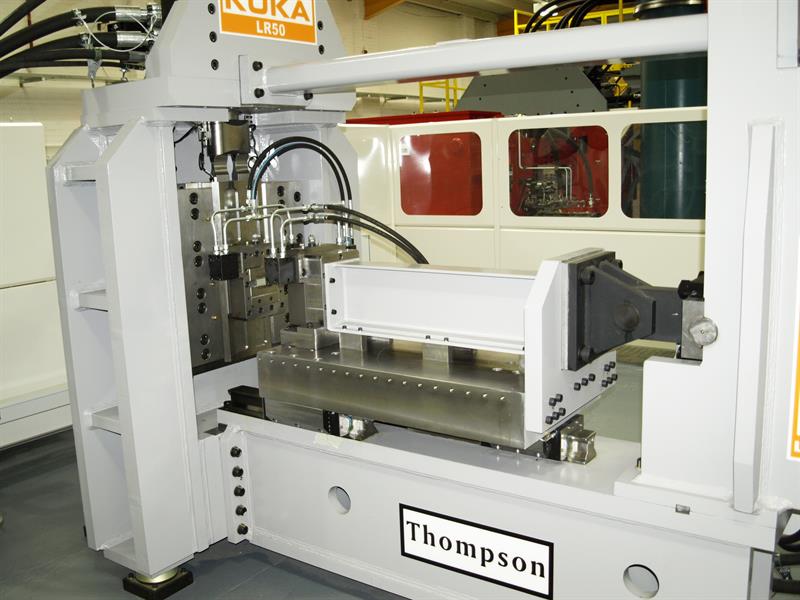TiFab, a three-year, £2.6 million programme that studied 174 titanium alloy aircraft components to assess their suitability for an advanced joining process based on linear friction welding (LFW), has just concluded. It has been determined by the project’s consortium, which comprises CAV Advanced Technologies, Kuka Thompson (https://is.gd/hocata), TWI (https://is.gd/opepir) and Ten Solutions, that LFW offers the potential to save 50-75% on raw material costs, matched by a similar reduction in machining time.
For the 174 parts that were sent to the consortium by aircraft OEMs, LFW delivered a 100% success rate. Moreover, if applied in production, the process would save 206 tonnes of titanium (worth approximately £9 million) per year, as compared to machining parts from solid.
Explains Bryan Humphreys, technical director at CAV Advanced Technologies, a supplier of aircraft components: “By machining from solid, aircraft use approximately their own weight in raw titanium; however, the final machined parts represent just 5% of aircraft weight. There is clearly a huge inefficiency here that needs to be addressed, not to mention the fact that future potential shortages of titanium could threaten worldwide supply, and that making titanium is not a particularly environmentally friendly process.”
With these facts in mind, the aim of TiFab, which was backed by government-backed innovation agency Innovate UK, was to show how near-net-shape manufacture could boost productivity by using tailored blanks to produce lightweight titanium alloy parts. LFW was selected ahead of other welding or deposition techniques because of its speed and ability to achieve material properties that, subject to the application of post-weld heat treatment, are equal to or exceed those of the parent material. LFW shows distinct advantages over conventional rotary friction welding, for example, as the weld surfaces are more evenly heated.
NO LIMIT BUT THE MACHINE
According to Humphreys, the weld area is only restricted by the physical size of the LFW machine. However, the parts do not have to be similar in size; smaller components can be joined with much larger ones.
“LFW uses oscillation and hot forging to join components, ultimately delivering excellent grain structure, along with impressive fatigue and tensile performance,” he adds. “All of the welds produced as part of TiFab exhibited a characteristic fine-grained, equi-axed microstructure, free from voids, surface contaminants and alpha-case [oxygen-enriched] ingress within the weld line. The welding time is rapid, typically between 0.7 and 6.3 seconds, while at an average rubbing velocity of 400 mm/sec, pressures between 80 and 150 MPa [80-150 N/mm2] were found to be most effective.”
Bertrand Flipo, senior project leader at TWI, has the scientific evidence to support the metallurgy claims. As part of the TiFab process, he was tasked with looking at joint performance data for Ti-6Al-4V grade 5 (specification AMS4911) and providing an LFW parametric assessment, as well examining post-weld heat treatment and static and fatigue loading.
Based on a series of 120 experimental welds with a classic ‘faying’ area of 40 by 25 mm, TWI examined parameters such as pressure, cold deformation properties, amplitude/frequency, forge duration, thermal behaviour and the impact of welding in atmospheric conditions. With regard to this last factor, an argon shield is normally required for welding titanium, as oxygen in the weld line is not conducive to good joint properties.
“We found that the welds produced by LFW were not affected by the unprotected atmosphere, making it a significant process advantage,” says Flipo. “Based on amplitudes of between 1 and 3 mm, frequencies of 20-75 Hz, forge duration up to 60 seconds and various pressures, we also discovered that Ti-6Al-4V has a very wide process window. Adjusting many of the parameters had little effect on weld integrity, which was consistently good. We also found that the process is not volume dependent; it is possible to weld a workpiece as large as you can imagine in fewer than 10 seconds. The only factor that determines weld integrity is time, but this is very quick. Indeed, the process exhibits thermal gradients of up to 3,600°C per second, which means it takes just a fraction of a second to reach the forging temperature of titanium at around 650-700°C, where it becomes a welded joint.
“Clearly, what matters to the industry is how quickly we can weld, but this is not about how long it takes to realise the joint, but how long it takes to cool,” he continues. “With this in mind, we focused on keeping the material in forge until it reaches the temperature at which it oxidises. For example, to reach 300°C, parts typically require waiting around 6.5 seconds; still sub-10 seconds, making it a very quick cycle time.”

ATiFab part showing, left, the welded assembly and, below, machined result
PARENT METAL EQUIVALENCE
Most impressive of all was the post-weld, post-heat-treatment integrity of the material, which compared extremely favourably with the parent workpieces.
“Based on a very high sample of specimens, we were well above the minimum fatigue allowable data, according to MMPDS [Metallic Materials Properties Development and Standardisation], the go-to reference for design-allowable properties used by the aerospace industry,” Flipo explains. “In fact, after heat treatment, we were consistently better than the parent material, in terms of fatigue performance. I don’t know of any other welding processes where this is the case. With regard to tensile performance (cross-weld), the parts produced using LFW offered very close to, or the same results as, the parent material.
“We can therefore say it is possible to build safely using LFW,” he adds. “Putting LFW-produced parts on aircraft will see the weld behave at least as well as the parent material.”
In short, LFW produces a defect-free, solid-state bond which achieves a 100% cross-sectional weld, without the need for consumables. For Kuka Thompson (Kuka acquired Thompson Friction Welding in 1993), the potential is considerable. The company has, in fact, been developing LFW for over a decade, working closely with what it describes as “all the major aerospace OEMs, including Boeing and Airbus”.
Today, Kuka Thompson can offer LFW machines ranging from 5 to 300 tonne in forging capacity (LR5, LR20, LR50, LR100/130, LR200 and LR300 models).
On site, the company has an LR50, which is used as a subcontract resource, working with potential customers to prove-out components. Although no LFW machines have been sold to date, Kuka Thompson says that the next phase for a number of aerospace OEMs is to produce parts that will be trialled in flight. Once this step is concluded, the expectation is for the flood gates to open.

Importantly, the LFW process can also be applied to other aerospace materials, such as Inconel, Al-Li alloys, 7000 series aluminium alloys, copper and even ferrous materials such as steel. Indeed, an AL-Li fuselage stringer produced by LFW showed a 50% material saving in comparison with existing extrusion techniques. As a point of note, LFW can also join dissimilar metals.
“The many successful trials to date include an 11-part titanium assembly measuring 650 mm in length, where overall dimensions were held to within 50 micron,” says Kuka Thompson’s engineering manager Stephen Reed. “Meanwhile, a wing rib has also been successfully produced from 7000 series aluminium alloy, a very expensive raw material, demonstrating considerable savings. Titanium blisks are among other aerospace parts being manufactured using LFW. Due to the high added value of such components, we have an uninterruptable power supply that works on stored energy technology to make it failsafe.”
Beyond the actual LFW process, each stage of the tailored blank manufacturing process has been carefully analysed as part of TiFab to identify the process variables that need to be controlled. For example, the impact of the taper angles on waterjet cut billets was assessed to see the effect on the subsequent LFW process. Understanding this relationship and what LFW could tolerate was vitally important, as it defines the quality and utilisation of the waterjet cutting machines required to produce a given number of tailored blank components.
An independent, in-process quality monitoring (IPQM) system was also designed as part of the procedure development to comply with product QA requirements.
A review of the current in-process data monitoring approaches was carried out and the most suitable manner to monitor the LFW process was defined. This was followed by the design and build of a test system that focused on high speed monitoring, forces and displacements, and other key process factors. The IPQM’s system capability was proven using normal and intentionally off-normal weld samples.
System output is a weld report that offers evidence to empower LFW process engineers in their decision-making roles. The report includes information on topics such as weld qualification, SPC and QA. This monitoring system project should be transferable to other LFW machines in the future, it is said.
Thompson was established in 1865, predominantly specialising in boiler fabrication work for the Black Country region. And although the company first began exploring the technology of friction welding some 50 years ago, its full potential clearly remains untapped.
Main article ends
Box item
Detailed cost analysis
Alan Shilton, principal consultant at Ten Solutions, a specialist in business and project management, was tasked with identifying the cost of the TiFab process.
“Although almost all new technological breakthroughs are heralded, in reality people simply want to know how much they cost,” he says. “For this reason, we built a cost model of the entire value stream, using Industry 4.0 and digital factory tools to map and simulate production operations.”
The TiFab manufacturing process ranges from raw material preparation (typically waterjet cutting of titanium blanks), LFW, weld flash removal and ultrasonic/visual inspection, through to heat treatment in a vacuum furnace, machining to tolerance, deburring/fettling, final inspection/measurement, packing and shipping. Added to this were costs associated with raw material, fixtures/tooling, cycle time durations, labour (at various skill levels), overheads, such as energy, and other fixed costs, such as rent to cover floor space requirements for the LFW machine, vacuum furnace and other process equipment.
Shilton’s research also determined what size any LFW machine should be, so as to meet 80% of current market requirements for titanium alloy structural aircraft parts: 50 tonnes (forging cylinder force). This is why the principal LFW machine in situ at Kuka Thompson’s Halesowen facility is an LR50 (50 tonne) model complete with 0-100 Hz oscillation unit to create the necessary friction.
“From our cost analysis studies, we determined that a 50-tonne LFW machine and its downstream related activities account for only 18% of the total production cost, which completely blows the myth that LFW machines are expensive,” Shilton highlights. “Furthermore, if adopted at an aerospace facility producing titanium parts, we estimate that one LFW could replace the requirement for four CNC machining centres.
“According to our projections, there is a £100 million market for LFW machine sales globally. This is in addition to £1.2 billion of subcontract opportunities. These are huge numbers for a relatively small sector of aircraft part production.”
Article first published in Machinery, August 2017




